

Just because the processor and chipset support these capabilities doesn't mean you'll see them in all laptops some of them, such as implementing PCIe Gen 4, are subject to individual manufacturers' preferences and product-line strategies. So speedier storage in larger capacities. (It's similar to AMD Smart Access Memory, which debuted with the Radeon RX 6000 series desktop cards in October 2019.) It also lets manufacturers incorporate bootable SSD RAID arrays using Intel's Rapid Storage Technology. That means it takes less time to move the graphics data for rendering out to the display, and can eke out some extra graphics performance.

One is Resizeable BAR, which allows the system to allocate an optimal amount of video memory for the CPU to use for graphics operations not otherwise run on the GPU. That's where Intel debuted the Tiger Lake-H architecture and related process, which (in conjunction with the 500-series chipset) adds support for Thunderbolt 4, Killer Wi-Fi 6E/Gig+, DDR4-3200 memory, dual built-in displays, Optane H20 and 20 lanes of PCIe Gen 4.īecause the Gen 4 allows direct connection to the CPU rather than using a separate bus, it brings with it a couple of notable capabilities for power users.

If it weren't for the ancillary technologies that come with Intel's latest round of Tiger Lake Core H-series CPUs, today's 11th-gen launch could seem like kind of a snoozefest. Razer's Blade 15 Advanced bumps the line up to incorporate Core i9 with the new i9-11900H.


 0 kommentar(er)
0 kommentar(er)
